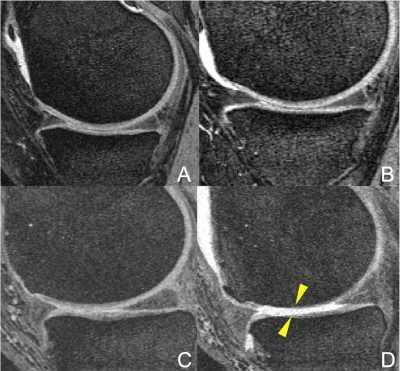
18 Nov Knee Arthritis: Study Compares Effects of Elliptical Training vs Racket Sports
MedicalResearch.com Interview with:
Silvia Schirò MD
Department of Radiology and Biomedical Imaging
University of California, San Francisco
MedicalResearch.com: What is the background for this study?
Response: Knee osteoarthritis (OA) is worldwide the second most frequent cause of lower extremity disability, and it has a global incidence of 199 cases per 100.000, including over 14 million people with symptomatic knee OA in the US. Overweight and obese individuals have a higher incidence of knee OA due to excessive knee joint load. The association between physical activity and knee OA, has not been systematically addressed in overweight and/or obese subjects and its association seems to be controversial. On the one hand, mild to non-weight-bearing physical activities have been found to be beneficial in the management knee homeostasis, the physiologic knee joint load providing an optimized environment for the joint tissues. On the other hand, excessive fast-paced physical activity with high load-joint torsion such as racquet sports, ball sports and running have been found to have an increased incidence of knee injury compared to mild-moderate exercise such as swimming, bicycling and low-impact aerobics independent of body weight.

MR images of the right knee (A, B, C, D) at baseline (A, C) and after 48 months (B, D). Overweight 47-year-old woman in the elliptical trainer group (A-B) and overweight 64-year-old man in the racket sports group (C-D). The man in the racket sports group developed severe cartilage damage at the femur and tibia bones (arrowheads). In contrast, no cartilage damage was seen in the woman in the elliptical trainer group (A-B).
Credit: RSNA
MedicalResearch.com: What are the main findings? Are there other risk factors associated with this finding?
Response: The main findings are that progression of overall knee joint degeneration was consistently higher in overweight and/or obese subjects engaging in racquet sports compared to subjects engaging in different types of physical activity such as jogging/running, bicycling, swimming, ball sports and elliptical trainer. The lowest rate of progression of knee degenerative changes was found in subjects working out with an elliptical trainer. Moreover, we found that runners showed the second lowest knee joint degeneration rate instead of the “recommended” low impact activities for the management of knee OA such as bicycling and swimming. Our hypothesis is that fast-paced and high shear load physical activities such as racquet sports are more harmful for the overall knee joint health and in particular for the cartilage than low impact or low shear stress activities in obese and overweight individuals. In contrast to the other activities evaluated in this study, racquet sports include frequent and high-intensity, direct, lateral movements, as opposed to activities that mostly involved forward movements (running, elliptical, swimming, and bicycling) or forward/ diagonal movements (ball sports). A large lateral force imparted at the foot during side-to-side movements may be driving large knee adduction moments, a key feature in medial compartment disease, which imparts high compressive loads on the medial tibia and femoral condyle
MedicalResearch.com: Are there exercise activities which are associated with a reduced risk ie using an elliptical trainer?
Response: In our study we found that workouts using an elliptical trainer were associated with reduced progression of overall knee joint and cartilage defects. A recent study showed that overweight and obesity are associated with greater vertical loading rates and increased risk for total knee replacement surgery, thus restricted weight bearing exercises should be preferred in order to lose weight and reduce the excessive knee joint overload. Our regional analyses, showing a strong association for the medial knee, support this hypothesis, although our work adds a key component of reducing activities that include cutting and have high shear loads such as racquet sports. Moreover, our findings also showed that when comparing different low impact activities with each other such as bicycling, elliptical trainer and swimming, the elliptical trainer was associated with the lowest increase in degenerative changes over 48 months.
MedicalResearch.com: What recommendations do you have for future research as a result of this study?
Response: Thank you for this important question. It would be interesting for future research studies to study prospectively the association between different physical activities and knee OAI regarding the amount of time spent doing these activities that would be best suited to prevent knee degenerative disease progression.
MedicalResearch.com: Is there anything else you would like to add? Any disclosures?
Response: This is one of the first research projects that studied a large cohort of exclusively overweight and obese subjects (n=415) regularly practicing different types of physical activities over 48 months and comparing them with each other. Moreover, progression of knee degeneration was evaluated using advanced and sensitive imaging technologies (3T MRI) precisely analyzing cartilage, meniscal and bone marrow damage. Thus, our results which show differences in the structural progression of overall knee joint and cartilage degeneration detected with these advanced methods are novel compared to previous studies, which analyzed smaller study cohorts and used less sensitive imaging techniques such as radiographs. Our study was funded through the National Institutes of Health (NIAMS). We do not have any disclosures.
Citation:
[subscribe]
Last Modified: [last-modified]
The information on MedicalResearch.com is provided for educational purposes only, and is in no way intended to diagnose, cure, or treat any medical or other condition. Always seek the advice of your physician or other qualified health and ask your doctor any questions you may have regarding a medical condition. In addition to all other limitations and disclaimers in this agreement, service provider and its third party providers disclaim any liability or loss in connection with the content provided on this website.
Last Updated on November 18, 2020 by Marie Benz MD FAAD
